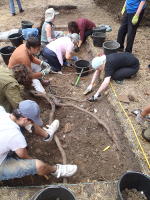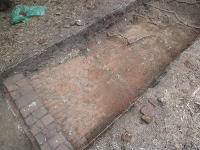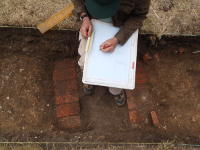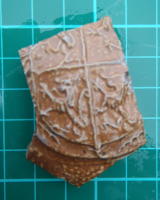15 Jul 2017
Forty Hall Summer Dig - Day 4

Today's digging focused mainly on the eastern extension to trench 2, looking to expose more of the brick floor within our Tudor palace building and continuing the search for an east end to the building range.
The east end of this trench is characterised by large tree roots (from the lime tree avenue), which overlay a noticeably thicker deposit of demolition rubble at the far end of the trench, consisting mostly of large brick and roof tile fragments.
This area had a distinct straight edge, paralell to the interior partition wall and floor edge in the middle of the trench, and we suspected this might be an early sign of the extent of the floor and perhaps the demolished remains of the end of the building.
This end of trench 2 is not yet fully excavated, but at the moment it looks like we were at least half right: The brick floor does seem to end roughly where the large roots begin, but at the moment there is no sign of structure beneath the rubble beyond.

We've now exposed about twice as much of the brick floor as yesterday, and it appears to be fairly consistent all the way across - heavily worn bricks lain edge-on with perhaps a slight dip in the middle.
Again, this area is not yet fully excavated - one of the most interesting parts will be its eastern edge, which may yet tell us if our building ends here or if there's yet another room.
The most tantalising feature of the floor, though, is the rectangular gap in the southern side of the trench, which revealed a layer of bricks beneath. These bricks seem to be similarly laid, but crucially are on a different alignment. This could well be an earlier floor - we will definitely need to extend the trench south to see more.

We're now sure the double wall we uncovered over by trench 1 is indeed a drain - it is quite a substantial construction consisting of two well built walls, which would probably have had an arched roof (we have seen several such examples elsewhere on site), although this would have made the drain very shallowly buried - it may alternatively have had a flat roof, perhaps of flagstones.
We began to excavate the fill of the drain today, which contained quite a few nice finds including tiny copper alloy clothes pins, a metal fixture we think from a shoe and quite a few animal bones. So far we've gone down seven courses of bricks and still haven't found the drain base.

One of the nicest finds from trench 1 was a fragment from a stoneware mug or jug, featuring a coat of arms - this was a common marketing gimmick in the 16th and 17th centuries, with such vessels commonly being made with coats of arms of various European royal families, sometimes quite shoddily with basic heraldic mistakes.
This one appears to feature four quartered lions rampant (not Enfields, as some of our diggers would have liked!) - and is probably the coat of arms of Owain Glyndŵr, the last native Prince of Wales from 1404 to his death in around 1415.
It's hard to think of a more ironic find than one commemorating a celebrated rebel against Lancastrian rule in the midst of a Tudor palace!